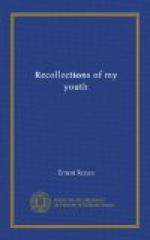the lowest possible point. The fanaticism of
the League, far from serving to make their morality
more rigorous, had just the contrary effect.
Priests thought that because they shouldered musket
and carbine in the good cause they were at liberty
to do as they liked. The racy humour which prevailed
during the reign of Henri IV. was anything but favourable
to mysticism. There was a good side to the outspoken
Rabelaisian gaiety which was not deemed, in that day,
incompatible with the priestly calling. In many
ways we prefer the bright and witty piety of Pierre
Camus, a friend of Francois de Sales, to the rigid
and affected attitude which the French clergy has
since assumed, and which has converted them into a
sort of black army, holding aloof from the rest of
the world and at war with it. But there can be
no doubt that about the year 1640 the education of
the clergy was not in keeping with the spirit of regularity
and moderation which was becoming more and more the
law of the age. From the most opposite directions
came a cry for reform. Francois de Sales admitted
that he had not been successful in this attempt, and
he told Bourdoise that “after having laboured
during seventeen years to train only three such priests
as I wanted to assist me in re-forming the clergy
of my diocese, I have only succeeded in forming one
and-a-half.” Following upon him came the
men of grave and reasonable piety whom I named above.
By means of congregations of a fresh type, distinct
from the old monkish rules and in some points copied
from the Jesuits, they created the seminary, that
is to say the well-walled nursery in which young clerks
could be trained and formed. The transformation
was far extending. The schools of these powerful
teachers of the spiritual life turned out a body of
men representing the best disciplined, the most orderly,
the most national, and it maybe added, the most highly
educated clergy ever seen—a clergy which
illustrated the second half of the seventeenth century
and the whole of the eighteenth, and the last of whose
representatives have only disappeared within the last
forty years. Concurrently with these exertions
of orthodox piety arose Port-Royal, which was far superior
to St. Sulpice, to St. Lazare, to the Christian doctrine,
and even to the Oratoire, as regarded consistency
in reasoning and talent in writing, but which lacked
the most essential of Catholic virtues, docility.
Port-Royal, like Protestantism, passed through every
phase of misfortune. It was distasteful to the
majority, and was always in opposition. When
you have excited the antipathy of your country you
are too often led to take a dislike to your country.
The persecuted one is doubly to be pitied, for, in
addition to the suffering which he endures, persecution
affects him morally; it rarely fails to warp the mind
and to shrink the heart.
Olier occupies a place apart in this group of Catholic reformers. His mysticism is of a kind peculiar to himself. His Cathechisme chretien pour la Vie interieure, which is scarcely ever read outside St. Sulpice, is a most remarkable book, full of poesy and sombre philosophy, wavering from first to last between Louis de Leon and Spinoza. Olier’s ideal of the Christian life is what he calls “the state of death.”




